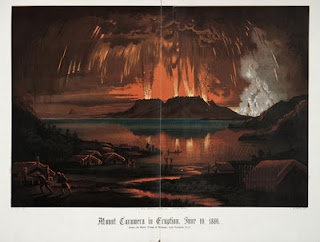 Cornel de Ronde is the world renowned GNS Science specialist in researching undersea volcanoes and hydrothermal activity. He has made numerous discoveries and had many adventures diving to the ocean floor in submarines of all shapes and sizes.
Cornel de Ronde is the world renowned GNS Science specialist in researching undersea volcanoes and hydrothermal activity. He has made numerous discoveries and had many adventures diving to the ocean floor in submarines of all shapes and sizes.
Visitors to Wellington’s Te Papa Museum may recognise him from the “Deep Ride” submarine experience.
In 1886 Mount Tarawera near Rotorua erupted with extreme violence for a few hours over one night in June. By morning, several settlements had been buried in hot ash and mud with the loss of over 100 lives, the world famous pink and white silica terraces had disappeared and a crater several kilometres long had opened up in a reshaped and devasted landscape.
 Lake Rotomahana, on whose shores the famous terraces had been located, had become part of the long, deep volcanic rift. Over time the lake refilled with water again to become a larger version of its former self.
Lake Rotomahana, on whose shores the famous terraces had been located, had become part of the long, deep volcanic rift. Over time the lake refilled with water again to become a larger version of its former self.
In January, Cornel will be leading a team of researchers from New Zealand and the US, to plumb the depths of Lake Rotomahana with two very high tech, automated underwater vehicles (AUVs). They will map the lake floor, identify the hydrothermal vents, and make numerous measurements of the chemical and physical properties of the lake water and hydrothermal fluids.
(Permission of the Alexander Turnbull Library, Wellington, New Zealand, must be obtained before any re-use of this image of the Tarawera Eruption.)
The detailed survey will enable the scientists to find out the fate of the Pink and White Terraces after the Tarawera eruption in 1886. These terraces were world famous in the nineteenth century for being the largest silica terraces o n the planet, and for their outstanding beauty and grandeur. Visitors used to wander over the terraces and bathe in the bath tub shaped depressions
n the planet, and for their outstanding beauty and grandeur. Visitors used to wander over the terraces and bathe in the bath tub shaped depressions
Tineke Berthelsen is one of the science team. She will be managing some of the practical aspects of the project and operating equipment when the research team is on site in late January.
We will be posting more information on this blog over the coming weeks. For a more in depth introduction to the project you can read the press release that has been publicised today.
Bookmark this blog or link up to our facebook page if you want updates about the background and science of this unique research project.

Caught you on the news tonight and thought how incredibly exciting it all looks and then read your release to the schools in Rotorua – I can't wait and my class will love it, I am there!!!! Fantastic work!
This looks like a fascinating project 🙂
Wow what a fantastic write-up! I'll visit your blog more often!